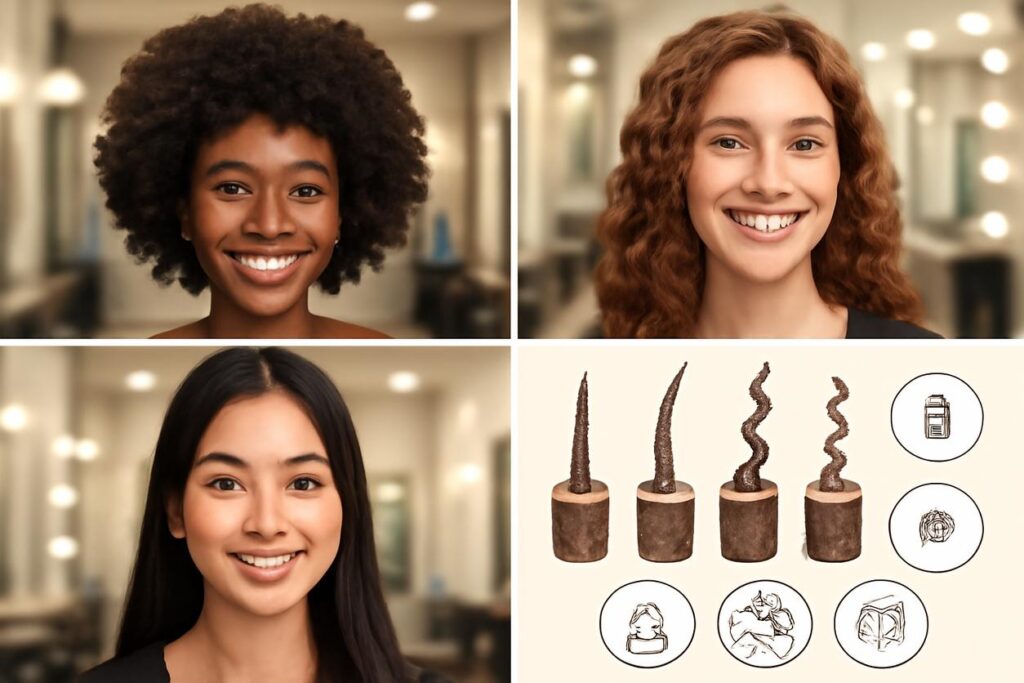Table of Contents
- Introduction: Why Your Hair Type Matters More Than You Think
- The Building Blocks: What Determines Your Hair Type?
- Discovering Your Strands: Simple At-Home Hair Tests
- The Four Main Hair Types: A Detailed Breakdown
- Tailored Care for Every Texture
- Building Your Perfect Routine: A Practical Guide for All Hair Types
- Smart Styling: How to Protect Your Hair’s Integrity
- The Ingredient Cheat Sheet: What Your Hair Loves and Hates
- Healthy Hair from the Inside Out: Nutrition and Lifestyle
- Common Hair Concerns and How to Troubleshoot Them
- Quick Identification Checklist
- Frequently Asked Questions (FAQ)
- Resources and Further Reading
Introduction: Why Your Hair Type Matters More Than You Think
Have you ever bought a product that everyone raved about, only to find it left your hair feeling greasy, dry, or completely unmanageable? You’re not alone. The secret to a great hair day isn’t about finding a miracle product; it’s about understanding your unique hair. Knowing your hair types and their specific needs is the foundation of a care routine that actually works.
But “hair type” is so much more than just straight, wavy, or curly. It’s a combination of factors, including your hair’s texture, its thickness, and how it absorbs moisture. This guide will demystify the world of hair types, helping you identify your own with simple at-home tests. By the end, you’ll be empowered to build a personalized, practical routine that brings out the best in your hair, making frizz, dryness, and frustration a thing of the past.
The Building Blocks: What Determines Your Hair Type?
Your hair’s personality is defined by four key characteristics. Understanding each one is crucial for decoding what your hair truly needs to thrive.
Hair Shape (Texture)
The most visible trait of all hair types is the texture, or curl pattern. This is determined by the shape of your hair follicles. Perfectly round follicles produce straight hair, while oval or asymmetrical follicles create wavy, curly, or coily hair. The flatter the follicle, the curlier the hair strand.
Hair Diameter (Thickness)
This refers to the thickness of an individual hair strand. It’s not about how much hair you have, but how wide each strand is. There are three categories:
- Fine: Strands are very thin and can be difficult to see. Fine hair is often delicate and can be weighed down easily by heavy products.
- Medium: The most common diameter, medium strands are thicker than fine hair and more resilient to styling.
- Coarse: Strands are thick, strong, and often feel more substantial. Coarse hair is generally more resistant to chemical treatments but can be prone to dryness.
Hair Porosity
Porosity is your hair’s ability to absorb and retain moisture. It’s determined by the structure of the hair cuticle, the outermost layer of the strand. Think of it like shingles on a roof. Tightly packed “shingles” mean low porosity, while raised or damaged “shingles” lead to high porosity.
Hair Density
Density refers to the number of individual hair strands on your scalp per square inch. You can have fine hair with high density (a lot of thin strands) or coarse hair with low density (fewer thick strands). It’s typically categorized as low, medium, or high.
Discovering Your Strands: Simple At-Home Hair Tests
You don’t need a lab to figure out your hair’s characteristics. These simple tests can give you valuable insight right at home.
The Strand Test for Diameter
Pluck a single strand of hair (or find one from your hairbrush). Take a piece of standard sewing thread and lay them side-by-side on a white surface.
- If your hair is thinner than the thread, you have fine hair.
- If it’s about the same width, you have medium hair.
- If it’s noticeably thicker, you have coarse hair.
The Float Test for Porosity
After washing and rinsing your hair to remove any product buildup, take a clean, dry strand and drop it into a glass of room temperature water.
- Low Porosity: If the strand floats at the top for a long time, your cuticles are tightly sealed.
- Medium (Normal) Porosity: If the strand floats for a bit and then slowly sinks, your hair absorbs moisture well.
- High Porosity: If the strand sinks almost immediately, your cuticles are open and absorb water quickly (but may lose it just as fast).
The Four Main Hair Types: A Detailed Breakdown
Hair texture is commonly categorized into four main families, with sub-classifications that describe the tightness of the wave or curl.
Type 1: Straight Hair
Straight hair grows straight down from the follicle without any bend or curl. It tends to be the oiliest of the hair types because sebum (natural oil) from the scalp can easily travel down the hair shaft.
- 1a: Completely straight and fine.
- 1b: Mostly straight with more body and a slight bend at the ends.
- 1c: Straight with a few subtle waves and a coarser texture.
Type 2: Wavy Hair
Wavy hair has a natural “S” shape. It’s more prone to frizz than straight hair but can be easily weighed down by heavy products.
- 2a: Fine, barely-there waves that are easy to straighten.
- 2b: More defined S-shaped waves that start from the mid-lengths.
- 2c: The waviest of this type, with defined waves starting from the root and a coarser texture.
Type 3: Curly Hair
Curly hair forms defined, springy curls or loops. This hair type is often dry because the twists and turns of the hair shaft make it difficult for scalp oils to travel down to the ends.
- 3a: Large, loose curls with a defined S-shape.
- 3b: Springy, voluminous ringlets, about the size of a marker.
- 3c: Tight, corkscrew curls, about the size of a pencil.
Type 4: Coily Hair
Also known as kinky hair, coily hair features very tight curls, zig-zags, or coils right from the scalp. It is the most fragile of the hair types and is prone to shrinkage and dryness.
- 4a: Tightly coiled S-curls that are visible and about the size of a knitting needle.
- 4b: Tightly crimped hair that bends in sharp Z-angles.
- 4c: Densely packed coils with less definition and more shrinkage than other patterns.
Tailored Care for Every Texture
Caring for different hair types isn’t one-size-fits-all. Each texture family has unique needs.
Care Principles for Straight Hair (Type 1)
The primary goal is to add volume and avoid oiliness. Use lightweight shampoos and conditioners. Avoid heavy creams or butters that can weigh hair down. Dry shampoo can be your best friend for refreshing roots between washes.
Care Principles for Wavy Hair (Type 2)
The focus here is on enhancing your natural wave pattern without causing frizz or weighing hair down. Use light-hold gels, mousses, or sea salt sprays. “Plopping” your hair in a t-shirt after washing can help define waves.
Care Principles for Curly Hair (Type 3)
Moisture is everything for curly hair. Consider co-washing (using conditioner to wash) or sulfate-free shampoos. Use leave-in conditioners and curl creams to define and hydrate your curls. Avoid brushing dry hair, which can disrupt the curl pattern and cause breakage.
Care Principles for Coily Hair (Type 4)
Coily hair requires maximum moisture and protection. Use rich, creamy deep conditioners and butters. Sealing moisture with oils (like jojoba or castor oil) is crucial. Protective styles like braids or twists can help minimize manipulation and retain length.
Building Your Perfect Routine: A Practical Guide for All Hair Types
Combining your texture with your porosity level is the key to a truly customized routine. Here’s a simple breakdown.
| Porosity Level | Routine for Straight/Wavy Hair (Types 1-2) | Routine for Curly/Coily Hair (Types 3-4) |
|---|---|---|
| Low Porosity | Use lightweight, hydrating products. Clarify regularly to prevent buildup. Apply products to damp hair and consider using gentle heat (like a warm towel) to help them penetrate. | Focus on moisture without heavy oils. Use water-based leave-ins and light creams. Steam treatments can help open the cuticle to allow moisture in. |
| Medium Porosity | Your hair is relatively low-maintenance. A balanced routine of hydrating and strengthening products works well. Occasional deep conditioning will keep it healthy. | A balance of moisture and protein is key. Regular deep conditioning and using layering methods like LCO (Liquid, Cream, Oil) will maintain health and definition. |
| High Porosity | Use protein-rich products to help fill gaps in the cuticle. Layering leave-in conditioners and light oils can help seal in moisture. Rinse with cool water to help close the cuticle. | Focus on sealing in moisture. Use thick creams, butters, and sealing oils. The LOC (Liquid, Oil, Cream) or LCO method is essential. Protein treatments can help strengthen strands. |
Smart Styling: How to Protect Your Hair’s Integrity
How you style your hair is just as important as the products you use.
Heat Styling with Care
If you use heat, always apply a heat protectant spray first. For your styling strategies in 2025 and beyond, invest in tools with adjustable temperature settings and use the lowest heat possible to achieve your look.
Gentle Detangling Techniques
Never detangle hair when it’s dry (unless you have Type 1). Work from the ends up to the roots using your fingers or a wide-tooth comb. Always detangle when hair is full of conditioner to provide slip and prevent breakage.
Protective Styles
For textured hair types, protective styles like buns, braids, and twists reduce daily manipulation, protect ends from damage, and help retain length. Be sure not to make them too tight, which can cause tension on the scalp.
The Ingredient Cheat Sheet: What Your Hair Loves and Hates
Ingredients to Look For
- Humectants: Glycerin, aloe vera, and hyaluronic acid attract moisture from the air into your hair.
- Emollients: Shea butter, coconut oil, and jojoba oil smooth the cuticle and lock in moisture.
- Proteins: Keratin, silk protein, and collagen help strengthen the hair shaft, especially for high-porosity or damaged hair.
Ingredients to Avoid
- Sulfates (SLS/SLES): Harsh detergents that can strip natural oils, leading to dryness and irritation.
- Drying Alcohols: Alcohol denat, isopropyl alcohol, and propanol can dehydrate hair.
- Silicones (non-soluble): Can build up on the hair, preventing moisture from penetrating the strand. Look for water-soluble silicones if you choose to use them.
Healthy Hair from the Inside Out: Nutrition and Lifestyle
Healthy hair starts from within. A balanced diet rich in vitamins and minerals is fundamental. For evidence-based information, check out resources like the National Center for Biotechnology Information. Key nutrients include:
- Protein: The building block of hair. Found in eggs, fish, and legumes.
- Iron: Essential for hair growth. Found in spinach, red meat, and lentils.
- Biotin: A B-vitamin linked to hair health. Found in nuts, seeds, and sweet potatoes.
- Omega-3 Fatty Acids: Support scalp health. Found in salmon, avocados, and walnuts.
Additionally, managing stress, staying hydrated, and getting enough sleep all contribute to a healthier scalp and stronger strands.
Common Hair Concerns and How to Troubleshoot Them
Tackling Frizz
Frizz is often a sign that your hair is thirsty. The solution is usually more moisture. Use anti-humectant products in humid weather and ensure your hair is properly hydrated with leave-in conditioners or creams.
Combating Breakage
Breakage can result from dryness, over-processing, or rough handling. Assess your protein-moisture balance—hair that feels mushy may need protein, while brittle hair needs moisture. Be gentle when detangling and styling.
Addressing Thinning
If you notice significant thinning, consult a healthcare professional or a dermatologist to rule out underlying health issues. Gentle scalp massages can help stimulate blood flow, and focusing on scalp health with targeted treatments can support a healthy growth environment.
Quick Identification Checklist
Use this flowchart-style checklist to get a quick read on your hair:
- Texture: When my hair air-dries, does it…
- Stay completely straight? -> Type 1
- Form a gentle S-shape? -> Type 2
- Form defined ringlets or spirals? -> Type 3
- Form tight coils or zig-zags? -> Type 4
- Porosity: In a glass of water, my clean hair strand…
- Floats at the top? -> Low Porosity
- Sinks slowly? -> Medium Porosity
- Sinks right away? -> High Porosity
- Diameter: Compared to a sewing thread, my hair strand is…
- Thinner? -> Fine
- About the same? -> Medium
- Thicker? -> Coarse
Frequently Asked Questions (FAQ)
Can my hair type change over time?
Yes, factors like hormones, age, and chemical treatments can alter your hair’s texture and porosity. What worked for your hair a few years ago might not work today, so it’s always good to reassess your routine periodically.
How often should I wash my hair?
This depends on your hair type and lifestyle. Oily, straight hair may need washing every 1-2 days, while dry, coily hair might only need washing once a week or even less. Listen to your hair and scalp.
Does hair density matter as much as texture?
Yes! Density affects the types of products you should use. Someone with low-density hair will want lightweight products to create volume, while someone with high-density hair may need stronger-hold products to manage their mane.
Resources and Further Reading
Ready to learn more? These resources provide a wealth of information on the science and care of all hair types.
- General Hair Information: For a deep dive into the biology of hair, the Hair Types Wikipedia page is a great starting point.
- Professional Hair Care Insights: Brands and experts often share educational content. For example, Rich Hair UK offers insights into various hair care topics.
- Scientific Research: To explore the science behind hair health and nutrition, visit the digital archive at the National Center for Biotechnology Information.





